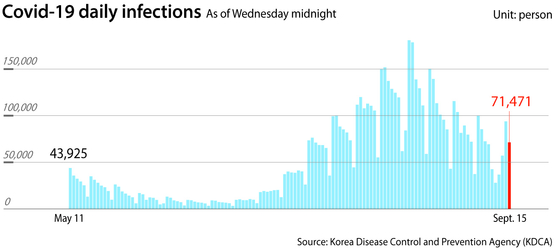WHO chief says end of Covid-19 pandemic is 'in sight'
![Students seeking for a job flood an annual job fair that was held face-to-face for the first time in three years hosted by the Busan National University on Thursday. [SONG BONG-GEUN]](https://koreajoongangdaily.joins.com/data/photo/2022/09/15/f38b3e50-6694-494d-8a5a-c7ecc247fbe0.jpg)
Students seeking for a job flood an annual job fair that was held face-to-face for the first time in three years hosted by the Busan National University on Thursday. [SONG BONG-GEUN]
The end of the Covid-19 pandemic is “in sight,” the World Health Organization (WHO) chief declared Wednesday.
Korea’s daily infections dropped into the 70,000s on Thursday after reaching nearly 100,000 after the Chuseok harvest holidays. The country reported 71,471 new Covid-19 cases Thursday, down 1.59 percent from the previous week’s 72,632 cases, according to the Korea Disease Control and Prevention Agency (KDCA).
In a press conference in Geneva on Wednesday, WHO Director-general Tedros Adhanom Ghebreyesus gave the most optimistic outlook yet on the years-long Covid-19 crisis.
“We have never been in a better position to end the pandemic,” Tedros said, citing last week’s number of weekly reported deaths from Covid-19, which was the lowest since March 2020.
“We are not there yet, but the end is in sight,” he said.
According to the WHO’s latest report, 10,935 Covid deaths were recorded around the world in the week of Sept. 5 to 11, which was a decrease of 22 percent compared to the week before.
In that same period, the number of new virus infections was 3,130,975, a drop of 28 percent from the previous week.
This was echoed in Korea's decline in new cases.
“In the short term, the declining trend may stagnate or turn to an increase temporarily following the increase in face-to-face meetings during the Chuseok holidays without distancing rules,” KDCA commissioner Peck Kyong-ran said during a briefing on Thursday.
“[But] the declining trend is expected to remain in the long run unless there are major variables, such as the spread of new virus variants.”
Korea’s Covid death rate has remained low.
According to the KDCA, the country’s fatality rate reached 2.1 percent in the early days of the pandemic, from Jan. 20 to Aug. 11, 2020.
That dropped to 0.04 percent from June 26 to Aug. 20, 2022 — similar to the death rate of seasonal influenza estimated by the WHO, which is between 0.03 to 0.07 percent. The KDCA believes the coronavirus can be treated like the seasonal flu if the fatality rate continues to decrease.

“The Covid-19 pandemic is at the end of a transition period and is close to a stable period,” Oh Myoung-don, a professor of infectious disease at Seoul National University Hospital, said in a recent interview with the JoongAng Ilbo. He called for changes to the government’s antivirus policy.
“During the transition period, the coronavirus becomes mild through repeating breakthrough infections and reinfections,” Oh said.
“We will prepare in close cooperation with experts in the stage of moving toward the end of the pandemic," KDCA commissioner Peck said following the WHO director-general’s remarks.
On Thursday, the government announced this year's flu vaccination plan as it braces for simultaneous outbreaks of Covid and seasonal influenza this fall and winter.
Under the plan, from Sept. 21, the country will offer flu shots for free at some 20,000 hospitals nationwide, starting with children who have never received flu shots.
From Oct. 10, other children and pregnant women will be eligible, and from Oct. 12, the elderly.
BY SEO JI-EUN [seo.jieun1@joongang.co.kr]










with the Korea JoongAng Daily
To write comments, please log in to one of the accounts.
Standards Board Policy (0/250자)